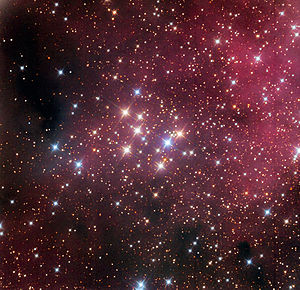Messier 29

|
|
| Messier 29 captured by the 81 cm reflecting telescope of the Mount Lemmon Observatory | |
| AladinLite | |
| Constellation | swan |
|
Position equinox : J2000.0 |
|
|---|---|
| Right ascension | 20 h 23 m 56 s |
| declination | + 38 ° 31 ′ 24 ″ |
| Appearance
|
|
| classification | III, 3, p, n (Trumpler), d (Shapley) |
| Brightness (visual) | 6.6 likes |
| Brightness (B-band) | 7.30 mag |
| Angular expansion | 7 ' |
| Number of stars | 50 |
| Brightest star | 8.59 likes |
| Physical data
|
|
| Redshift | (-7.0 ± 0.9) · 10 -5 |
| Radial velocity | (−21 ± 3) km / s |
| distance | 4000 ly (1200 pc ) |
| diameter | 11 years |
| Age | approx. 10 million years |
| history | |
| Discovered by | Charles Messier |
| Discovery time | July 29, 1764 |
| Catalog names | |
| M 29 • NGC 6913 • C 2022 + 383 • OCl 168 • Cr 422 • Lund 952 • OCISM 36 | |
Messier 29 (also known as NGC 6913 ) is a +6.6 mag bright open star cluster with an angular extent of 7 ' in the center of the constellation Swan . It stands 1.7 ° south of the star Sadr (γ Cyg) in a very star-rich region of the Milky Way and can only be seen in binoculars as a small nebula, in which Messier only recognized 8 stars in 1764. Due to the arrangement of the 7 brightest stars, the group is also called the "little Pleiades".
Because of the star clouds passing through the swan , it is difficult to differentiate the cluster members from the numerous background stars. Accordingly, the earlier Becvar catalog only gave 20 stars, but other authors up to 300. The distances given by various sources range from 3700 to 6000 light years, according to SEDS it is 4000 light years.

